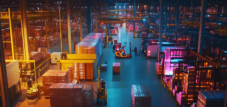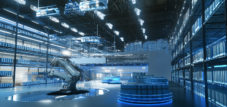Published on: May 20, 2025 / Update from: May 20, 2025 - Author: Konrad Wolfenstein

Transport performance with rail freight transport - efficiency, security and climate protection: 1,404 tons of freight train vs. 52 trucks - picture; Xpert.digital
90 % CO₂ savings: Why the rail is a better choice - more rail, less CO₂
Rail freight transport: sustainable and resilient alternative for goods transport
The rail freight transport is increasingly establishing itself as a load -bearing pillar of a sustainable logistics landscape. The ecological, economic and safety -relevant advantages of goods transport on the rail are diverse and underpin its importance for a future -proof transport industry. This analysis illuminates the various aspects that speak for increased use of the rail in freight traffic.
More about it here:
- Goods from the street on the rail: Logistics hobs & high-tech-locations for envelope, logistics, trade and production
Ecological advantages of rail freight transport
The transport of goods on the rail offers significant environmental advantages compared to conventional road freight transport. The numbers speak a clear language: a freight train causes only a quarter as much carbon dioxide per ton and kilometers as a truck. In more detail, rail freight transport only emits 15.2 g greenhouse gases per tons of kilometers, while the truck transport is 100.2 g/tkm.
This environmental balance is confirmed by concrete practical examples. The first test transport of the organic fruit and vegetable porter Lehmann Natur show that around 65 percent of CO₂ emissions could be saved from the road from the street to the majority of the route. In comparison between pure truck transport and combined traffic, up to 90 percent less CO₂ can be released depending on the connection.
The proportion of rail freight transport in the entire greenhouse gas emissions of the transport sector is only 0.84 percent, although it is responsible for 18.5 percent of German freight transport. Even a single percentage point higher market share on the rail means an annual saving of 644,000 tons of CO₂ compared to truck transport.
Capacity and efficiency in rail freight transport
A decisive advantage of rail freight transport lies in its superior transport capacity. A single freight train can replace up to 52 trucks, which significantly relieves both the climate and the streets. This considerable transport performance is made possible by the impressive size and capacity of modern freight cars.
According to its own statements, Deutsche Bahn AG has around 78,000 own freight wagons of different designs. Some of these cars can reach a length of up to 20 meters and load with 60 tons of goods. In particular, the covered, large -scale sliding walls, which are often used in practice, offer a load room of 160 m³ and can absorb 24 to 56 Euro pallets.
In short, the average charging capacity of a truck is about 27 tons. A freight train that can replace 52 trucks takes over a transport output of around 1,404 tons!
This high transport capacity leads to positive scale effects, since the fixed costs can be distributed to a larger amount of goods, which increases the economy of rail transport, especially on longer distances.
Electrification and energy efficiency
The rail freight transport is characterized by its advanced electrification. 97 percent of rail freight transport is already being handled with electrical electricity. This electricity comes to a growing share of renewable energies - 41.4 percent, according to the Federal Environment Agency, with increasing tendency.
Economy degree of the rail network
- Around 62 % of the German Federal Railout Act are currently electrified.
- As means: only around two thirds of the entire length of the route have overhead line and can be used by electrol locomotives.
- According to the coalition agreement, 75 % of the routes should be electrified by 2030 (coalition agreement 2025 between the CDU, CSU and SPD).
Share of electrically provided traffic performance
- 97 % of the transport performance in rail freight transport is provided electrically.
- That means: Almost all freight trains, measured by the transported amount and distance (toned kilometers), drive with electricity.
Main traffic axes are electrified
The most important and most used routes (main axes, corridors, international connections) are almost completely electrified. The majority of freight transport takes place here.
Side routes are usually not electrified
The non-electrified routes are predominantly side routes with low traffic. They make up a large part of the route length, but only a small part of the transport performance.
Example for illustration
- Route length: 62 % electrified → refers to the entire network.
- Transport performance: 97 % electrical → refers to the actually driven toned kilometers.
The rail also scores with excellent energy efficiency. Due to the significantly reduced roller resistance - steel wheels on steel rails cause less friction than rubber -tires vehicles on asphalt - the drive energy can be implemented much more efficiently into kinship. This leads to a significant energy advantage: Depending on the transport goods and distance, energy savings per tons of kilometers are already possible up to 75 percent.
For example, diesel trucks require almost four times as much energy per toned kilometer as freight trains via the Brenner Pass. After commissioning the burner base tunnel, this difference will even increase six times.
Economic consideration and external costs
When evaluating various means of transport, the external costs must also be taken into account - those follow -up costs that are not borne by the cause. A study by the Swiss consulting company Infras shows: While the truck causes 4.46 cents per toned kilometer of uncovered follow -up costs, it is only 2.04 cents per tons of kilometers in rail freight transport.
These external costs arise, among other things, by noise, natural and landscape damage, climate sequences and accidents. The largest cost block in the truck is the climate element, followed by upstream and downstream processes such as the production and scrapping of the vehicle and the streets as well as the production of the fuel.
The transfer of traffic on the rail therefore proves to be economically useful, especially if the entire social costs are included in the consideration. With an electrification of 1,728 km route or 2,395 km tracks, an annual benefit of EUR 1.67 billion could be generated according to the usual calculations of the Federal Transport Infrastructure Plan.
Resilience and security
The rail freight transport offers significant advantages with regard to resilience and security. The risk of accidents on the rail is around 40 times lower compared to the road, which leads to a significantly lower failure rate of shipping goods. With the few accidents on the rail, the risk of total loss is less than in the case of accidents in road traffic.
The risk of theft is also significantly reduced when transporting rail transport. Freight cars in the track bed are more difficult for potential thieves and are particularly difficult to unload than parked trucks.
The special strength of rail freight transport is shown in times of crisis. Whether during the Corona Lockdown, at border closures, in Brexit or in the face of geopolitical conflicts-rail freight transport proves to be a robust backbone for resilient supply chains. Improved network resilience due to targeted electrification could secure 3.68 billion tons of freight for rails annually, even if main tracks are due to disorders or maintenance work.
Suitable for:
- Dual-use logistics: The key to resilient supply chains (reading time: 29 min / no advertising / no paywall)
Challenges and development potential
Despite the diverse advantages, rail freight transport faces considerable challenges. The electrification of the rail network is progressing slowly. 62 percent of the federal rail network are currently electrified, and according to the coalition agreement, it should be 75 percent. In order to achieve this goal, the electrification would have to be promoted eight times as quickly as before.
The many construction sites on the rails have sometimes significantly affected freight traffic. Suitable alternative routes are missing to remain efficient despite construction work. The electrification program for the creation of alternative routes announced by the Federal Ministry of Transport is inadequate: of 173 -examined routes, only two alternative routes with a length of 143 route kilometers are to be electrified.
Another challenge is the necessary advance and follow-up with trucks. Since many companies do not have a direct rail connection, the goods must be reloaded frequently. In addition, train transport usually takes one day longer than pure truck transport, which can be a disadvantage for time-sensitive goods.
From road transport to rail: opportunities and challenges in freight transport
The rail freight transport offers enormous potential for sustainable and resilient transport industry. With his ecological advantages, its superior capacity and economic strengths, he can make a significant contribution to achieving the climate goals. The climate protection goals in the transport sector can hardly be achieved without increasing use of the rail.
The political goals are ambitious: the proportion of the rail on Modal Split is to be raised to 25 percent by 2030. To achieve this, however, considerable investments in the infrastructure are necessary. The Germany -Takt, which integrates timetables for freight traffic into the total timetables, can shorten the transport times and increase competitiveness.
The resilience of the rail network must be strengthened by further electrification and the creation of alternative routes. Only a resistant network can meet the requirements of growing rail freight transport and ensure reliable transport chains.
The relocation of freight traffic from the road to rail is not only an ecological but also an economic bid. The lower external costs, higher energy efficiency and the scale effects make rail freight transport a sustainable and future -oriented alternative for the goods transport of tomorrow.
Suitable for:
Advice - planning - implementation
I would be happy to serve as your personal advisor.
Head of Business Development
Chairman SME Connect Defense Working Group
Advice - planning - implementation
I would be happy to serve as your personal advisor.
contact me under Wolfenstein ∂ Xpert.digital
call me under +49 89 674 804 (Munich)















